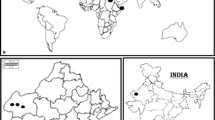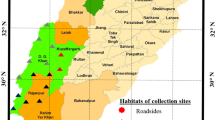Abstract
Fritillaria cirrhosa D. Don (Liliaceae), a valuable and critically endangered medicinal herb of northwest India, including Jammu and Kashmir, grows in temperate to alpine regions of the Himalaya. The bulbs of the plant are very valuable and are used to cure asthma, tuberculosis, haematemesis and many other health complications. The species faces threat due to multiple factors including habitat loss, over-exploitation for medicine, domestic and commercial trade. The present study was therefore undertaken to develop ex situ conservation strategies and domestication protocols for Fritillaria cirrhosa. The experimental treatments utilized to enhance the regeneration potential, growth and development of Fritillaria cirrhosa include soil texture variation, fertilizer treatment and farmyard manure treatment. The highest values of phenotypic attributes of the plants were recorded in soil: sand combination of 3:1. The plants prefer to grow in low sandy soils. Maximum plant height was attained in a combination of urea (nitrogen), diammonium phosphate (phosphorous) and potash (potassium) fertilizers. The plants depicted an admirably increased height and flower length in 1:1:2 combination and highest flower and leaf numbers in 2:1:1 combination of soil: sand: farmyard manure. Thus, low sandy soil with high organic matter was found to be favourable for better growth and development of the plants of Fritillaria cirrhosa.






Similar content being viewed by others
References
WCSP (2015) World checklist of selected plant families. Facilitated by the Royal Botanic Gardens, Kew. Published on the Internet; http://apps.kew.org/wcsp/. Accessed 05 Sept 2015
Dhyani A, Nautiyal BP, Nautiyal MC (2010) Importance of Astavarga plants in traditional systems of medicine in Garhwal, Indian Himalaya. Int J Biodiv Sci Ecosyst Serv Manag 6(1):13–19
Chauhan RS, Nautiyal MC, Vashistha RK, Prasad P, Nautiyal AR, Kumar A, Teixeira da Silva JA (2011) Morpho-biochemical variability and selection strategies for the germplasm of Fritillaria roylei Hook. (Liliaceae)—an endangered medicinal herb of Western Himalaya, India. J Plant Breed Crop Sci 3(16):430–434
Khare CP (2007) Indian medicinal plants: an illustrated dictionary. Springer-Verlag New York Inc., New York
Prakash K, Nirmalaa A (2013) A review on conservation of endangered medicinal plants in India. Int J Ethnomed Pharmacol Res 1(1):21–33
Sultan R, Wani MA, Nawchoo IA (2013) Unabated loss of medicinal plant diversity in Himalaya: a serious socio-economic concern and urgency to salvage whatever is left. Global Adv Res J Med Plants 2(1):012–021
Dhyani A, Nautiyal BP, Nautiyal MC (2010) Importance of Astavarga plants in traditional systems of medicine in Garhwal, Indian Himalaya. Int J Biodiv Sci Ecosyst Serv Manag 6(1):13–19
Wang D, Wang S, Du Q, Wang N, Liu S, Wang X, Jiang J (2014) Optimization of extraction and enrichment of steroidal alkaloids from bulbs of cultivated Fritillaria cirrhosa. BioMed Res Int. doi:10.1155/2014/258402
Wang DD, Feng Y, Li Z, Zhang L, Wang S, Zhang CY, Wang XX, Liu ZY (2014) In vitro and in vivo antitumour activity of Bulbus Fritillariae cirrhosae and preliminary investigation of its mechanism. Nutr Cancer 66(3):441–452
Wang D, Zhu J, Wang S, Wang X, Ou Y, Wei D, Li X (2011) Antitussive, expectorant and anti-inflamatory alkaloids from Bulbus Fritillariae cirrhosae. Fitoterapia 82(8):1290–1294
Wang DD, Wang S, Feng Y, Zhang L, Li Z, Ma J, Luo Y, Xiao W (2014) Antitumour effects of Bulbus Fritillariae cirrhosae on Lewis Lung carcinoma cells in vitro and in vivo. Ind Crops Prod 54:92–101
Wang D, Wang S, Chen X, Xu X, Zhu J, Nie L (2012) Antitussive, expectorant and anti-inflamatory activities of four alkaloids isolated from bulbs of Fritillaria wabuensis. J Ethnopharmacol 139(1):189–193
Khan SK, Karnat NM, Shankar D (2005) India’s foundation for the revitalization of local health traditions. Herbal Gram 68:34–48
Chauhan RS, Nautiyal MC, Teixeira da Silva JA, Prasad P, Purohit H (2011) Habitat preference, ecological parameters and conservation of Fritillaria roylei Hook., an endangered medicinal herb of the Astavarga Group. Biorem Biodiv Bioavail 5(1):73–76
Kala CP (2000) Status and conservation of rare and endangered medicinal plants in the Indian trans-Himalaya. Biol Conserv 93(3):371–379
Ved DK, Goraya GS (2008) Demand and supply of medicinal plants in India. Bishan Singh Mahendra Pal Singh, Bangalore
Abrahamson WG, Gadgil M (1973) Growth form and reproductive effort in golden rods (Solidago, Compositae). Am Nat 107:651–661
Blanchart E, Albrecht A, Bernoux M, Brauman A, Chotte JL, Feller C, Gany F, Hien E, Manlay R, Masse D, Sall S, Villenave C (2007) Organic matter and biofunctioning in tropical sandy soils and implications for its management. In: Kaen K (ed) Management of tropical sandy soils for sustainable agriculture : a holistic approach for sustainable development of problem soils in the tropics, Bangkok, pp. 224–241
Sitthaphanit S, Limpinuntana V, Toomsan B, Panchaban S, Bell RW (2009) Fertilizer strategies for improved nutrient use efficiency on sandy soils in high rainfall regimes. Nutr Cycl Agroecosyst 85:123–139
Nisar S (2010) Development of Agro-techniques and tissue culture protocols for cultivation and conservation of two important medicinal plants-Angelica glauca Edgew. and Rosmarinus officinalis Linn. Dissertation, University of Kashmir
Rather AM (2011) Reproductive biology of Valeriana jatamansi Jones. Dissertation, University of Kashmir
Gul S, Khan MH, Khanday BA, Nabi S (2015) Effect of sowing methods and NPK levels on growth and yield of rainfed maize (zea mays L.). Scientifica 1:1–6
Malghani AL, Malik AU, Sattar A, Hussain F, Abbas G, Hussain J (2010) Response of growth and yield of wheat to NPK fertilizer. Sci Int 24(2):185–189
Ogbomo KEL, Ogbomo JEL (2009) The performance of Zea mays as influenced by NPK fertilizer application. Not Sci Biol 1(1):59–62
Shrivastava HN (2008) Plant physiology, Biochemistry and Biotechnology. Pradeep Publications, Jalandhar
Abdulaziz M, Pokluda R, Abdulwahab M (2007) Influence of compost, microorganisms and NPK fertilizer upon growth, chemical composition and essential oil production of Rosmarinus officinalis L. Not Bot Hort Agrobot Cluj 35(1):86–90
Akparobi SO (2009) Effect of farmyard manures on the growth and yield of Amaranthus Cruentus. Agric Trop Et Subtrop 42(1):1–4
Garg J, Kumar A (2012) Effect of various organic nutrients on growth, biomass yield and hydrocarbon production of Euphorbia lathyris L., a hydrocarbon yielding plant. Int J Life Sci Pharma Res 2(4):83–99
Gopichand Meena RL (2015) Standardization of agrotechnique of Aloe vera in Mid hills of Western Himalaya. Global J Res Med Plants Indigen Med 4(5):88–94
Pal Y, Singh RP, Sharma NL, Sachan RS (2007) Effect of integrated nutrient management practices in rice (Oryza sativa L.) in a Mollisol. Pantnagar J Res 5(2):23–28
Phirke NV (2001) Biotech inputs for improving the yield of Banana. Dissertation, North Maharashtra University
Sharma R (2002) Aushdhiya Avyam Sugandhiya Paudhon Ki Krishi Technique (Agro-technique of medicinal and aromatic plants). Daya Publishing House, Delhi
Mohil P, Jain U (2014) Application of NPK and farmyard manure on biomass production of Amaranthus palmeri Wats. Asian J Plant Sci Res 4(2):7–12
Suge JK, Omunyin ME, Omami EN (2011) Effect of organic and inorganic sources of fertilizer on growth, yield and fruit quality of egg plant (Solanum Melongena L.). Archiv Appl Sci Res 3(6):470–479
Acknowledgments
The authors wish to acknowledge the Department of Botany, University of Kashmir for providing all necessary facilities during the research period.
Author information
Authors and Affiliations
Corresponding author
Ethics declarations
Conflict of interest
The authors declare no conflict of interest.
Rights and permissions
About this article
Cite this article
Shafi, H., Nawchoo, I.A., Shah, S.A. et al. Ex Situ Conservation Strategies for Fritillaria cirrhosa D. Don (Liliaceae): A Critically Endangered Medicinal Herb of Kashmir Himalaya. Proc. Natl. Acad. Sci., India, Sect. B Biol. Sci. 88, 33–41 (2018). https://doi.org/10.1007/s40011-016-0726-y
Received:
Revised:
Accepted:
Published:
Issue Date:
DOI: https://doi.org/10.1007/s40011-016-0726-y




